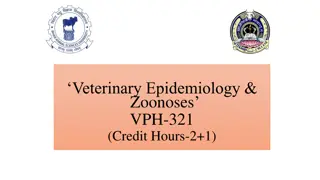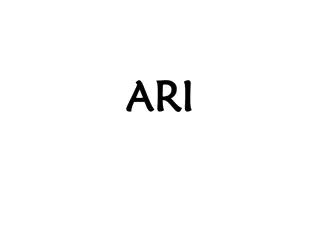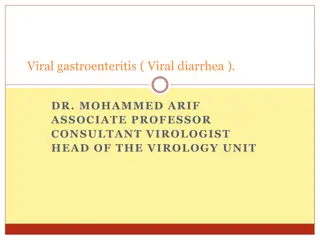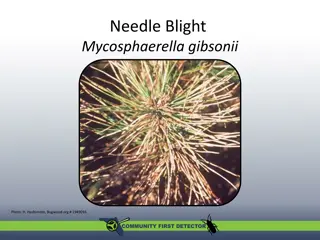Understanding Glanders: Causes, Symptoms, and Transmission
Glanders, also known as Farcy, Equinia, or Malleus, is a contagious disease affecting horses, mules, and donkeys. It is caused by the bacteria Pseudomonas mallei and can be transmitted through direct contact or inhalation. The disease manifests with nodules or ulcers in the respiratory tract and on the skin, affecting different forms in various hosts. Clinical signs range from local cutaneous lesions to severe systemic infections. Understanding the etiology, transmission, and pathogenesis of Glanders is crucial in prevention and control measures.
Download Presentation

Please find below an Image/Link to download the presentation.
The content on the website is provided AS IS for your information and personal use only. It may not be sold, licensed, or shared on other websites without obtaining consent from the author. Download presentation by click this link. If you encounter any issues during the download, it is possible that the publisher has removed the file from their server.
E N D
Presentation Transcript
UNIT UNIT- -5 5 GLANDERS Anil Kumar Anil Kumar Asst. Professor Asst. Professor Dept. of VCC Dept. of VCC
GLANDERS Synonyms: Farcy/Equinia/Malleus It is an acute to chronic contagious disease of horse, mules and donkeys characterized by nodules or ulcers in the respiratory tract and on the skin. Glanders terms used when the principal lesions are seen in the nostrils, submaxillary glands and lungs & farcy when lesions are on the surface of limbs or body. Etiology: Pseudomonas mallei Actinomyces mallei Burkholderia mallei (Gram ve bacillus) Host affected: It affects the Solipeds (mammals with single hoof like Horses, mules, donkey In horses chronic form occurs commonly and in mules and donkeys acute forms occurs. It can also infect Carnivores
Cattle & swine are resistant Human & goat are susceptible In human it occurs in 4 forms; Local cutaneous form Pulmonary form Septicemic form Chronic form In World War-I, the organism was used as Biological agent to infect the Russian horses, mules & human In World War-II, used it to infect the horses, prisoners of the war & opponent s horses by Japanese. Transmission: Mainly transmitted by direct contact with infected animals In animals the disease is transmitted through ingestion & inhalation and the transmission is enhanced by shared water & feeding facilities In human, through Inhalation, abraded skin & mucous membrane are the main source
Pathogenesis: Organism after ingestion Organism after ingestion Intestine Intestine Blood Blood Bacteraemia and Bacteraemia and Septicemia Septicemia Nasal mucosae, lower parts of Nasal mucosae, lower parts of turbinates and Lungs and Lungs turbinates On Skin commonly of hind limb On Skin commonly of hind limb In limbs, lymphadenitis and In limbs, lymphadenitis and lymphangitis occur occur lymphangitis Nodules develops on the nasal Nodules develops on the nasal cavity and skin which ulcerates and cavity and skin which ulcerates and may coalesce may coalesce togather togather The The lymph lymph nodes vessels vessels are are swollen discharging discharging dark as Farcy as Farcybud bud . . The thickened thickened and and become farcy farcy cord cord nodes all swollen and dark honey honey color The lymph become cord all along along the and rupture color pus lymph vessels cord like like , , known the lymph lymph rupture with pus known known vessels are known as with In lung, bronchopneumonia In lung, bronchopneumonia occurs and the military tubercle occurs and the military tubercle like lesions are produced like lesions are produced are as The limb is swollen and appears like the The limb is swollen and appears like the limb affected with elephantiasis. This limb affected with elephantiasis. This cutaneous form in known as farcy cutaneous form in known as farcy
Clinical Signs and Symptoms: Glanders in equine occurs in 3 forms: 1. Nasal 2. Cutaneous and 3. Pulmonary forms
Glanders in equine occurs in 3 forms: 1. Nasal 2. Cutaneous and 3. Pulmonary forms Nasal form: Characterized by unilateral or bilateral nasal discharge. The yellowish-green exudate is highly infectious. The nasal mucosa has nodules and ulcers which may coalesce to form large ulcerated areas. In some cases the septum may even be perforated. Nasal lesions are accompanied by enlargement or sometimes rupture and suppuration, of regional lymph nodes Lesions may also occur in the liver or spleen and, in male animals , glanderous orchitis is a common lesion
Cutaneous Form: Development of multiple nodules in the skin of the legs or other parts of the body . These nodules may rupture, leaving ulcers that discharge a yellowish exudate to the skin surface and having tendency to heal slowly. Cutaneous lymphatic vessels become distended and firm by being filled with a tenacious, purulent exudate referred to as "Farcy pipes/cord .
Pulmonary form: The lesions in the lungs develop along with nasal and cutaneous lesions or there may be the sole manifestation of the disease (typical of latent cases). The lung lesions begin as firm nodules or as a diffuse pneumonic process. The nodules are gray or white and firm, surrounded by a hemorrhagic zone, and may become caseous or calcified. Clinical signs in animals with lung lesions may range from in apparent infection to mild dyspnea, or severe coughing Extensive pyogenic granulomatous pneumonia in a donkey
Diagnosis: Signs & symptoms Culture & isolation of bacteria Serological tests :- Indirect hemagglutination, Counter-immunoelectrophoresis Immunofluorescence Compliment fixation and ELISA Compliment fixation and ELISA: Most reliable in horses Cannot be used in donkey or mule Mallein test
Mallein test: Mallein is a protein that is not toxic to animals, but animals infected with glanders may become allergic to mallein & exhibit local or systemic hyper- sensitivity reaction after inoculation. A positive response is indicated by ocular swelling, photosensitivity, lacrimation & suppurative inflammation within 48 hours after injection. Intradermo-palpebral mallein test used, where 0.1ml of mallein is injected intr-dermally into the lower eye lid by tuberculin syringe and needle and results are recorded after1-2 days later with eyelid swelling, blepharospasms conjunctivitis. Treatment: Cull the affected animals because of zoonotic importance. If necessary, Antibiotics are used in combination. It is long term treatment up to weeks Sulphadimidine for 20 days is found highly effective. and purulent
Prevention & Control No vaccine is available for animal use. Quarantine measures (Place and Importation) Identification and removal of foci of infection through: Surveillance and monitoring of herds especially in endemic areas Positive animals should be isolated & slaughtered immediately & carcass should be disposed off by incineration or deep burial In-contact & exposed animals should be segregated , Re- tested to detect and destroy the positives according to the Glander & Farcy Act ,1899.























